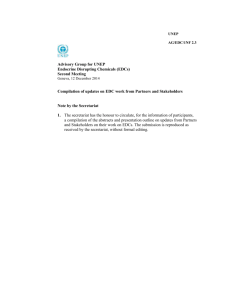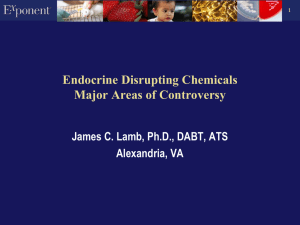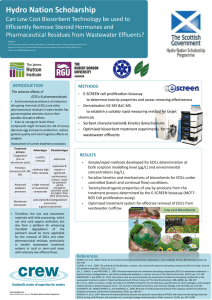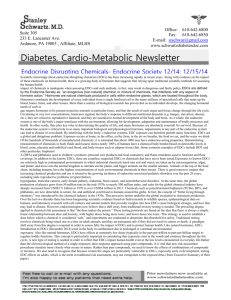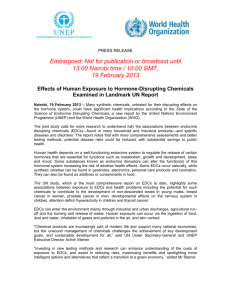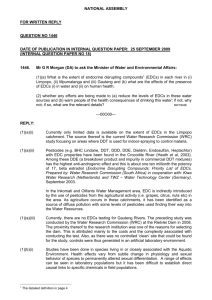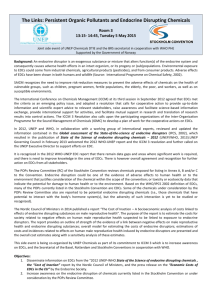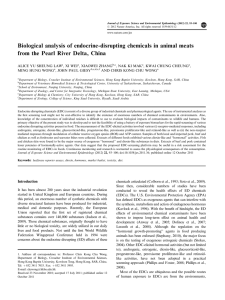BR EDs ES - European Public Health Alliance
advertisement
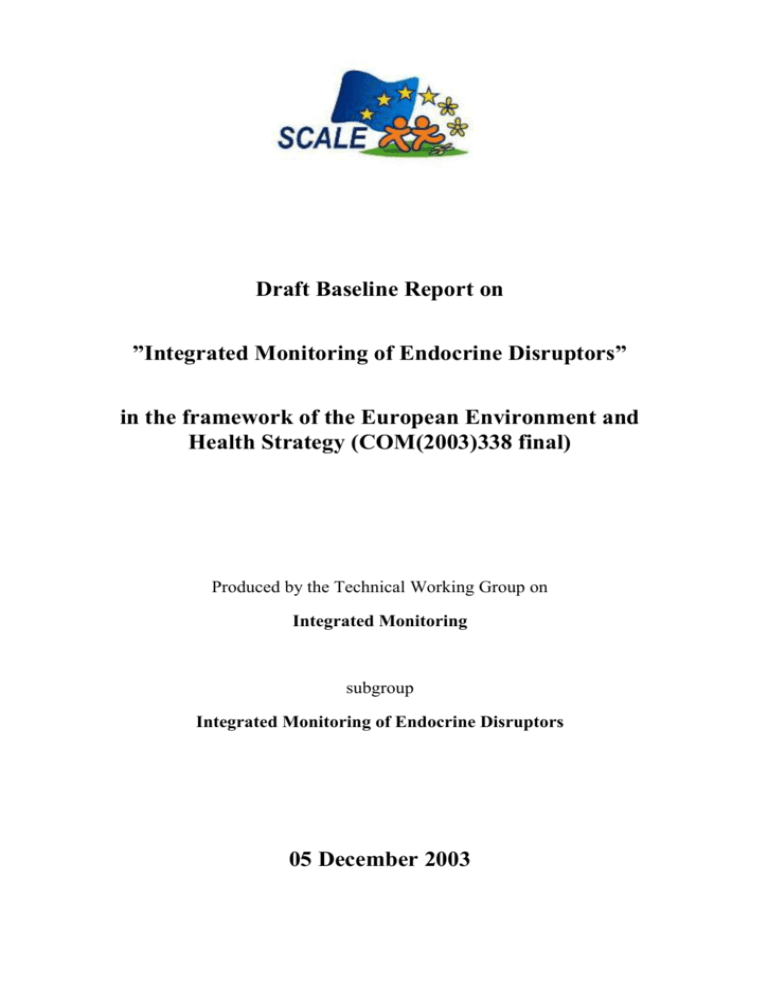
Draft Baseline Report on ”Integrated Monitoring of Endocrine Disruptors” in the framework of the European Environment and Health Strategy (COM(2003)338 final) Produced by the Technical Working Group on Integrated Monitoring subgroup Integrated Monitoring of Endocrine Disruptors 05 December 2003 This report reflects the opinions of the members of the Working Group and it highlights the different opinions contained within the group where appropriate. It should not be considered as an official statement of the position of the European Commission. Further information relating to this work is available on the project website: www.environmentandhealth.org or from the Technical Secretariat: Dr Martin Adams AEA Technology Environment Culham Science Centre Abingdon Oxfordshire OX14 3ED United Kingdom Telephone +44 870 190 6402 Facsimile +44 870 190 6615 Email Martin.L.Adams@aeat.co.uk 2 Members of the sub-group on Endocrine Disruptors Alberto Mantovani (Chair) José Tarazona (Chair) Annika Hanberg (Co-chair) Dominique Belpomme Poul Bjerregaard (also Research TWG member) Teresa Borges Diego Di Lorenzo Barbara Heinrich-Hirsch Peter Illig Walter Janssens Gernot Klotz Claude Lambré Emmanuel Lemazurier Erik Lovgren Jan K Ludwicki Gwynne Lyons Alberta Mandich Marco Martuzzi Richard Moxon Nicolas Olea Aengus O'Marcaigh Dirk Pallapies Renate Paumann Maria Reis Carla Sampaio David Sears Caoimhe Wright DG ENV: Claudia Roncancio-Pena Contractor AEA Technology: Yvonne Allen, Martin Adams 3 EXECUTIVE SUMMARY 1. The Technical Working Group for Integrated Monitoring of Endocrine Disrupters was tasked with two exercises: to provide an overview of monitoring activities in Member States and Acceding countries, and to provide an analysis of this overview, with particular emphasis on requirements for and advantages of an integrated monitoring system, problems and deficits currently identified and missing links for integrated monitoring. This report fulfils this mandate. The Technical Working Group was also charged to make proposals for preventive actions such as further legislation, regulation, enforcement of monitoring/emissions compliance, education and information programmes. These will be the subject of a subsequent report. 2. Eleven EU countries provided information and data on activities relevant to an integrated monitoring system for known and potential endocrine disrupting chemicals for the overview. Additionally, inputs were received by nongovernmental organisations. Subsequent analysis was based upon this information. 3. The TWG recognised the need to prioritise candidate endocrine disrupting chemicals (EDCs) for integrated monitoring, based on both toxicological information and assessment of available exposure data, according to current criteria of risk analysis. During the present exercise, the 66 "Category 1" list of substances as presented in the BKH report for DG Environment (study prepared in the framework of the "Community Strategy for Endocrine Disrupters") - (Annex 4) was used to identify EDCs targeted by monitoring activities. The TWG largely agreed with this approach; however, CEFIC expressed concern about defining EDCs as a group of compounds which should mostly be considered as “candidate” substances. The large majority of TWG members recognised that this group of substances cannot be taken as a “definitive” list of EDs and it is likely to undergo significant changes as a result of more in-depth evaluation; nevertheless it was deemed to be the best starting point for the overview of existing monitoring practices. However, individual countries were given the option of providing information on monitoring activities of other substances if they considered that ED is a suspected mechanism for effect. 4. In addition, the TWG agreed that, in order to obtain a realistic assessment of exposure to chemicals with potential endocrine activities, attention should also be given to data bases on monitoring of natural, synthetic and/or plant hormones in environment and foods, besides xenobiotics. 5. Three sources of data were considered, namely: Annex 1- Environmental Monitoring, including collection of data on EDCs in water, soil, sediments, food and air as well as on biota (both tissue residues and biosensors/biomarkers) and consumer products; Annex 2 - Biomonitoring activities on EDCs in human samples (e.g., breast milk, placenta, urine) as well as the existence of biobanks and the purpose(s) for collection of tissue samples and measurements; Annex 3 - Health Effects Monitoring, including those effects that may have a plausible association 4 with exposure to EDCs during early life stages (e.g., hypospadia; precocious puberty; endometriosis; breast cancer; testicular cancer) as well as the existence of registries or other kinds of data collection, their duration and coverage. Although there were different views within the TWG about the weight of evidence for EDCs as causative factors, there was general agreement that exposure to EDCs needs to be considered in the context of other risk factors for the diseases highlighted. The TWG recognised that the strength of association is highly variable for each effect considered, nevertheless all of them are recognised to have an underlying endocrine basis. PROBLEMS AND DEFICITS 6. From the evidence currently available, a preliminary conclusion is that comparatively limited activities are specifically targeted to monitoring of EDCs; substantial targeted information is expected in the forthcoming years through the development of major European research initiatives, such as the CREDO cluster. It is important that as the monitoring system is developed it remains an iterative process, thus taking into account information from research as the results become available. 7. There is nevertheless a considerable amount of information from both monitoring programmes and research activities, which are relevant to monitoring of EDCs, that can become a major target for an integrated monitoring system. Such activities span from monitoring programmes of environment, biota and foods through to registries of diseases that may be associated to stressors of the endocrine system. Integrating available data sources, rather than devising a new monitoring system has been identified as the actual priority. The aim of an integrated monitoring system should be to link up different data sources that are primarily collected for different purposes but which may acquire an “integration added value”. 8. Carefully dealing with the issues of data quality and comparability will improve in a European-wide monitoring system using harmonised protocols for sampling, chemical and bioanalysis as well as harmonised diagnostic criteria for health effects. The TWG recognises that other risk factors (e.g. social, dietary, lifestyle and genetic) can significantly contribute to the development of these diseases and should also be considered in monitoring. The TWG ED also emphasises the need to collaborate with the other TWGs to consider these aspects, in order to give a realistic assessment of the impact on public health of environmental stressors as a whole. REQUIREMENTS 9. A tiered approach, where targeted action is driven by signals, may be the best way forward. Such signals may include hotspots of exposure, of markers of effects on biota, or hotspots of potentially relevant health effects; however, in the latter case it needs to be recognised that for some diseases and disorders the suspected exposures may have occurred many years earlier during in-utero development. Therefore, the development of biobanks can play a useful role as they will enable 5 earlier exposures to be identified with greater confidence and to pinpoint possible risk factors for populations/groups with high incidence of certain health effects. 10. Specific collections of exposure data might be required for some compounds and/or some areas missed or poorly covered by current data sources. For instance, from an epidemiological point of view, it seems to be preferable to first get a sound base within the EU countries for the comparison of data on health effects and indicators which have been suggested to be associated with exposure to EDC: examples include male reproductive tract abnormalities (hypospadias, cryptorchidism), precocious puberty, testicular cancer, sperm quality, indicators of fecundity and fertility. There is also a general lack of data on internal exposures, and particularly tissue banked specimens, that would enable the tracking of later disease incidence and the identification of possible associations with in-utero exposures. 11. There are limitations to epidemiological methods in that current data sources clearly do not allow a firm evaluation of causal links between exposure to EDC or other endocrine-active compounds and health effects. Nevertheless, following integration, they can be exploited to provide a strong background of information to investigate causes of health effects. 12. Issues to be implemented further through integrated research and regulatory efforts include: the development, validation and widespread availability of relevant biosensors able to identify a full range of major ED mechanisms in diverse matrices; the integration of biosensors with chemical analytical methods, which will likely be a major step forward in the evaluation of complex mixtures of EDCs. 13. Also required is the development of reliable, relevant and validated biomarkers of effect and susceptibility, exploiting the rapid progress of genomics and proteomics in, e.g. medical endocrinology and reproductive biology. Characterisation of reference values for main EDCs is a necessity in order to understand exposure data, in particular for biomonitoring, where factors able to modify reference values in a population (e.g. age, sex, lifestyles, nutrition) should be identified and weighed. 14. In particular, integrated monitoring targeted on children's health should deal with specific issues, including, but not be limited to, focus on specific foods or consumer products, development of children-targeted biomarkers and careful attention to problems related to ethics, privacy and societal acceptance. 15. The same concept of “causal link” needs some rethinking when diseases of complex, multifactorial aetiology are considered (e.g., cancer, developmental disabilities and delays, etc.). The real target should be to understand the potential role of endocrine disruption as a risk factor in specific diseases for the general population (i.e., not following occupational exposures, chemical accidents, etc.). This will allow an estimation of the public health benefits as a result of control and 6 management of exposure, adoption of science-driven regulatory measures and identification of priorities for technological innovation. MISSING LINKS 16. Missing links identified include: i) better networking of environmental monitoring, better exploitation of known monitoring resources, improvement of information exchange and channels for communication at the intra- (e.g. among regions, agencies) and inter-member state level; ii) agreed commitment on a number of substances to be dealt with the approach of integrated monitoring including justification for their consideration as priority compounds; iii) promoting inputs from monitoring to research in order to clarify the scientific evidence of causeeffect relationships for chemicals with endocrine disrupting properties and suggested health effects. 17. The ideal integrated monitoring system is both cost-effective and science driven. To meet both criteria and focus on public health priorities, the system must be integrated with other risk factors that may play a role in relevant health effects. In this respect it is important to promote integration between research (providing innovative technologies and insights into effects/mechanisms) and control/management activities (providing needs, priorities, and a framework to apply the approaches developed by research). Moreover, a well-developed integrated European-wide monitoring system can exploit on-going wellfunctioning monitoring activities in order to provide positive, operational models. *** Further details of each of the sections summarised above are contained in the main body of the report. 7
